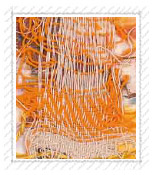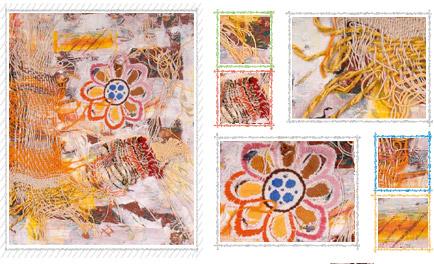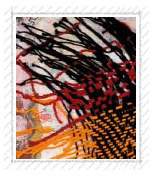| |
|
| |
 |
|
 |
| |
 |
|
|
Accade a volte di aver bisogno di colori. Colori forti che parlano di sole, di terra, di gioia, di paura. Accade anche di essere attratti dal ticchettio di un orologio e di accorgersi che il presente non esiste, perché quel rumore nello stesso istante in cui lo percepiamo è già passato. Accade soprattutto nelle giornate d’autunno, in cui anche le distrazioni sono attutite dalla nebbia.
Ho davanti frammenti di emozioni, la facoltà di scrivere per raccontarle e lo spazio infinito di tutte le possibilità di parola, eppure in questo oceano di offerte le parole giuste faticano a venire a galla. Cerco un foglio di carta e una matita, come se questa tastiera non fosse in grado di bastarmi, e scendo a un compromesso fra la tecnologia e l’antico: la possibilità di vedere tele che non
posso toccare semplicemente schiacciando un tasto e il desiderio di scrivere sentendomi padrona dell’atto, dando forma alle lettere, sottolineandole, e accarezzando il foglio se necessario, per sentire la complicità della carta. Con la matita in mano, l’apparire dei quadri di Rosa Spina, che sfilano sul video offrendomi le loro fragranze come cesti di fiori freschi, sembra essere sufficiente a innescare le frasi che voglio. Volere, ecco la chiave. Voler esternare un’emozione, (non una critica, non ho le competenze per poterlo fare) e volerlo fare nel più reale dei modi. Il pensiero corre ai colori, poi ai titoli, poi al vissuto e riporta le parole di Rosa Spina che racconta e si racconta.
|
|
|
| |
Sono parole d’amore per il filo, per il telaio e per le proprie mani che danno forma all’idea come se un quadro fosse un feto che, minuto dopo minuto, si nutre succhiando arte dal cordone ombelicale e matura, fino ad essere pronto...e le acque si rompono mentre ancora le mani aiutano i pensieri a preparare la culla dove adagiare la materia. Materia che non è più il singolo filo, la stoffa di sfondo, il colore o la colla, ma è già opera nella sua complessità fatta di storia e d’intreccio, di nodo e di passione. Tutto diventa prezioso, dalla seta alla iuta, dal broccato al sacco. Proprio come in un figlio, niente è lì per caso e quello che guardo è frutto di un preciso, necessario, immodificabile progetto.
|
|
 |
|
 |
| |
Scorrono i titoli e cerco oltre, il non detto e le leggende sono un cassetto dal quale Rosa Spina estrae la sua capacità di stupirmi. Sarebbe scontato parlare di forme e di colori. Invece basta la traccia giusta e un quadrato di 38 centimetri si trasforma in un libro che narra di Persefone e mi riporta sua madre Demetra che crea le stagioni affidando al freddo la terra, nel periodo in cui lei stessa ha il gelo dentro per la lontananza della figlia,
costretta a tornare nell’Ade. Sarebbe facile pensare alle Sirene collegandole a qualcosa di blu o di nero, a qualcosa che introduca l’ acqua. Invece è il giallo il colore predominante del dittico che parla di loro: il giallo é il colore del terzo Chakra, il colore del Plesso del Sole dal quale nasce la voglia di prendersi cura di sé e tutti ,come e Sirene, lo facciamo anche attraverso le nostre illusioni. I quadri di Rosa Spina? Emozioni che diventano tele e tele che catturano parole. Come fossero scampoli lasciati in un cassetto in attesa della giusta
possibilità di utilizzo sanno aspettare l’attimo giusto, il momento in cui guardandoli li vedi. In quel momento ti offrono la possibilità di leggerli. E leggere è una grande magia. |
| |
Scampoli di vita
Scampoli di vita
avvolgono ricordi e silenzi
e fermano nel presente
quello che il tempo inghiotte.
Sogni antichi e neonati
si affidano agli intrecci
come Calipso invoca
il ritorno di Ulisse
e le sirene tacciono
ingannando se stesse.
Scampoli di vita
e fotogrammi immobili
da appendere al silenzio
come fossero note. |
|
 |
|
Antonella Iaschi (2007) |
|
|
| Dal Catalogo "Defilage" di Rosa Spina a cura e con poesie di Antonella Iaschi |
| |
| |
|
 |
| |
| |
| |
| clicca sull'icona per vedere il Catalogo >> |
| |
| |
 |
 |
Remnants of life
Sometimes it happens that you need colours. Strong colours that speak of the sun, of the earth, of joy, of fear. It also happens that you are attracted by the ticking of a clock, and then you realize that the present does not exist, because in the same moment that we perceive it, it has passed away. This usually happens on autumn days, when even distractions are muffled by the fog. In front of me: fragments of emotions, the power of speech to write them down, and the infinite space of all the possible words. Still, in this ocean of suggestions, the right words struggle to surface. I look for a paper and a pencil, as if this keyboard could not be enough for me, and I reach a compromise between technology and tradition: the possibility of seeing paintings that I cannot touch by simply pressing a button, and the desire of mastering the act of writing, giving shape to the letters underlying them, and caressing the paper, when necessary, to feel its complicity. The pencil in hand, those Rosa Spina’s pictures appear and pass on the screen, and offer the scent of bouquets of fresh flowers: this seems enough to prompt the sentences that I want. To want---that’s the clue. Wanting to express an emotion (not a criticism, I would not be capable of doing that) and wanting to do it in the realest way possible. My thoughts run through the colours, through the titles, then to the experience and eventually relate Rosa Spina’s tales and words.
These words are words of love for the thread, for the loom and for her own hands that give shape to her ideas, as if the picture were an unborn child who, moment after moment, feeds itself by sucking Art through the umbilical cord, and grows, until it is ready… and then the waters break, while the hands are still helping the thoughts to prepare the cradle where the matter will be laid. That is no longer the single thread, the fabric of the background, the colour or the glue, but it has already become an artwork in its complexity, made of history and weaving, of knots and passion. Everything becomes precious, from silk to jute, from brocade to sackcloth. Exactly as for a child, nothing is there by chance, and what I see is the result of a precise, necessary, not modifiable project.
Titles pass on the screen and I look further on, the unsaid and legends are like a magician’s hat from which Rosa Spina pulls out her ability to astonish me. It would be predictable to speak about shapes and colours. Instead, she just needs the right idea and a 15-inch square becomes a book that tells of Persephone and reminds me of her mother Demeter who created seasons by freezing earth, when also her heart was frozen with despair because her daughter had been forced to go back to the underworld with Hades. It would be easy to think about Sirens by introducing something blue or black, something that recalls water. Nonetheless, yellow is the predominant colour in the diptych about Sirens: yellow is the colour of the Third Chakra, the colour of the Solar Plexus, from which originates the will to care about ourselves, and everybody, like Sirens, who do this through illusions as well. What about Rosa Spina’s compositions? Emotions that become pictures and pictures that catch words. As if they were remnants put in cold storage waiting for the right opportunity to be used, they are able to wait for the right moment, when you see them by looking at them. At that moment they will give you the opportunity to be read. And reading is sheer magic.
Antonella Iaschi (2007)
Traduzione di Luca Lampacrescia
|
|
| |
| |
|
|






